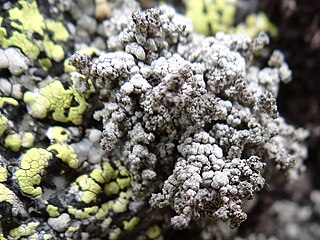
Phacopsis is a genus of lichenicolous (lichen-dwelling) fungi. They grow on parasitically on members of the large lichen family Parmeliaceae, of which they are also a member. Originally proposed by Edmond Tulasne in 1852 to contain 3 species, Phacopsis now contains 10 species, although historically, 33 taxa have been described in the genus. Many of the species are poorly-known, some of them having been documented only from the type specimen.
Nanostictis caucasica is a species of lichenicolous (lichen-eating) fungus in the family Stictidaceae. It is known to occur only in a single locality in the North Caucasus region of Southern Russia, where it grows parasitically on the foliose lichen Parmelia sulcata.
Clypeococcum bisporum is a species of lichenicolous (lichen-eating) fungus in the family Polycoccaceae. It is found in the Russian Far East, in Mongolia, and from northwest Alaska, where it grows parasitically on lichens from the genera Cetraria and Flavocetraria.
Endococcus hafellneri is a species of lichenicolous (lichen-eating) fungus in the family Verrucariaceae. It is found in North Asia and the Russian Far East, Estonia, and Japan, where it grows on the lobes of the lichens Flavocetraria cucullata and Cetraria islandica.

Stereocaulon vesuvianum is a species of snow lichen belonging to the family Stereocaulaceae.

Stereocaulon tomentosum is a species of snow lichen belonging to the family Stereocaulaceae.

Stereocaulon saxatile is a species of snow lichen belonging to the family Stereocaulaceae.
Stereocaulon symphycheilum is a species of snow lichen belonging to the family Stereocaulaceae.
Stereocaulon subcoralloides is a species of snow lichen belonging to the family Stereocaulaceae.
Stereocaulon botryosum is a species of snow lichen belonging to the family Stereocaulaceae.
Stereocaulon glareosum is a species of snow lichen belonging to the family Stereocaulaceae.
Stereocaulon intermedium is a species of snow lichen belonging to the family Stereocaulaceae.
Stereocaulon arenarium is a species of snow lichen belonging to the family Stereocaulaceae.
Stereocaulon rivulorum is a species of snow lichen belonging to the family Stereocaulaceae.
Stereocaulon myriocarpum is a species of snow lichen belonging to the family Stereocaulaceae.
Stereocaulon grande is a species of snow lichen belonging to the family Stereocaulaceae.
Polycoccum laursenii is a species of lichenicolous fungus in the family Polycoccaceae. It was first described as a new species in 2004 by Russian mycologist Mikhail Petrovich Zhurbenko. It is found in Alaska and in Russia.
Arthonia stereocaulina is a species of lichenicolous fungus in the family Arthoniaceae.
Endococcus nanellus is a species of lichenicolous fungus in the order Dothideales. It is known from Alaska, Canada, Greenland, Hawaii, Japan, Russia, South-Korea, and Kazakhstan.
Phacopsis vulpicidae is a species of lichenicolous (lichen-dwelling) fungus in the family Parmeliaceae. It was formally described as a new species in 2019 by mycologists Mikhail P. Zhurbenko and Paul Diederich. The type specimen was collected by the first author near the headwaters of Ar Khordolyn gol River in Renchinlkhümbe Somon, at an altitude of 2,050 m (6,730 ft). There, in the upper limit of a Larix sibirica forest, the fungus was found growing on the thallus of a ground-dwelling Vulpicida juniperina lichen. The species epithet vulpicidae refers to the genus of its host. Infections by the fungus cause blister-like (bullate) swellings of the host thallus. It is known to occur in arctic and mountain tundra and taiga biomes of Asia, Europe, and North America (Alaska). Its only recorded host is Vulpicida juniperina, and almost all recorded host specimens have been terricolous.



